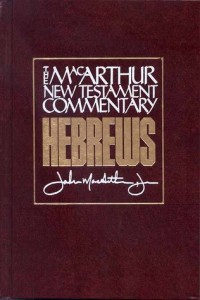MacArthur’s View of Hebrews 9:11-14
ESV Hebrews 9:11-14 But when Christ appeared as a high priest of the good things that have come, then through the greater and more perfect tent (not made with hands, that is, not of this creation) (not made with hands, that is, not of this creation)
12 He entered once for all into the holy places, not by means of the blood of goats and calves but by means of his own blood, thus securing an eternal redemption.
13 For if the blood of goats and bulls, and the sprinkling of defiled persons with the ashes of a heifer, sanctify for the purification of the flesh,
14 how much more will the blood of Christ, who through the eternal Spirit offered himself without blemish to God, purify our conscience from dead works to serve the living God.
CHARACTERISTICS OF THE NEW COVENANT
BUT – IN CONTRAST TO THE OLD – WHEN CHRIST APPEARED AS A HIGH PRIEST OF THE GOOD THINGS TO COME, HE ENTERED THROUGH THE GREATER AND MORE PERFECT TABERNACLE, NOT MADE WITH HANDS, THAT IS TO SAY, NOT OF THIS CREATION, NOT THROUGH THE BLOOD OF GOATS AND CALVES, BUT THROUGH HIS OWN BLOOD. He entered the holy place once for all, having obtained eternal redemption. For if the blood of goats and bulls and the ashes of a heifer sprinkling those that have been defiled, sanctify for the cleansing of the flesh, how much more will the blood of Christ, who through the eternal Spirit offered Himself without blemish to God, cleanse your conscience from dead works to serve the living God? (9:11-14)
MANY CHARACTERISTICS OF THE NEW COVENANT ALREADY HAVE BEEN MENTIONED OR IMPLIED IN THE DISCUSSION OF THE OLD. BUT THE WRITER HERE FOCUSES ON SEVERAL THAT ARE ESPECIALLY IMPORTANT IN CONTRASTING THE TWO COVENANTS.
FOLLOWING THE PATTERN USED IN SHOWING THE INADEQUACIES OF THE OLD COVENANT (VV. 1-10), THE NEW SANCTUARY, THE NEW SERVICES, AND THE NEW SIGNIFICANCE ARE DESCRIBED BRIEFLY. As always, the point is not to demean the old but to show its shadowy incompleteness. To condense and paraphrase verses 13 and 14, The Holy Spirit is saying “If these old things were so good as symbols, how much better are the real things they symbolize. If the eternal, physical, and temporary covenant accomplished its purpose so well, how much better will the internal, spiritual, and eternal covenant accomplish its purpose!”
THE NEW SANCTUARY
BUT WHEN CHRIST APPEARED AS A HIGHH PRIEST OF THE GOOD THINGS TO COME, HE ENTERED THROUGH THE GREATER AND MORE PERFECT TABERNACLE, NOT MADE WITH HANDS, THAT IS TO SAY, NOT OF THIS CREATION (9-11)
FIRST OF ALL, CHRIST, AS HEAVENLY HIGH PRIEST, HAD AN INFINITELY GREATER SANCTUARY IN WHICH TO MINISTER. THE OLD TABERNACLE WAS DESIGNED BY GOD, BUT IT WAS MADE BY MAN, OUT MATERIAL FROM THE PRESENT PHYSICAL CREATION. For that time and for that purpose, it was impressive. And on the inside, where only the priests could go, it doubtlessly was also beautiful. But it was only a tent. It is not mentioned here, but the Temple in Jerusalem, though immeasurable more magnificent than the Tabernacle, was also made by mane with materials from the present creation, and was subject to the deterioration and destruction to which everything of this creation is subject.
THE NEW SANCTUARY, HOWEVER, IS NOT MADE BY MAN OR ON EARTH, OR OF EARTHLY MATERIALS. IT IS MADE BY GOD, IN HEAVEN, AND OF HEAVENLY MATERIALS. THE NEW SANCTUARY, IN FACT, IS HEAVEN. Earth belongs to God, but heaven is His dwelling place, His throne, and His sanctuary (Acts7:48-50; 17:24). As the writer of Hebrews has pointed out several times, Jesus Christ, like Melchizedek, is a priest-king. And he rules and ministers from the same place. His sanctuary and his palace are the same. In this passage, of course, the emphasis is on His sanctuary. Heaven is the perfect tabernacle, not made with hands. Christ ministers for us in heaven, in the throne room of God at God’s right hand.
THE FORMER PRIESTS HAD TO GO INTO THE HOLY PLACE BY THEMSELVES, FOR THE PEOPLE, BUT NOT WITH THE PEOPLE. THE SAME WAS TRUE OF THE HIGH PRIEST IN REGARD TO THE HOLY OF HOLIES, WHERE HE COULD NOT EVEN TAKE OTHER PRIESTS. But our heavenly Priest takes His people with Him all the way into the sanctuary. He takes us into the sanctuary of sanctuaries, into heaven itself – not into the symbolic presence of God but into the real presence of God. Not only has He gone before us, but He takes us with Him.
IF WE ARE BELIEVERS, HE ALREADY HAS TAKEN US WITH HIM. “BUT GOD, BEING RICH IN MERCY, BECAUSE OF HIS GREAT LOVE WITH WHICH HE LOVED US, EVEN WHEN WE WERE DEAD IN OUR TRANSGRESSIONS, MADE US ALIVE TOGETHER WITH CHRIST… AND RAISED US UP WITH HIM, AND SEATED US WITH HIM IN THE HEAVENLY PLACES, IN CHRIST JESUS” (EPH. 2:5-7). When we were saved, Christ at that time took us into the Father’s presence, when, spiritually speaking, we already live with Him and will forever live with Him. We live right now in heavenly places, in the presence of God—in His throne room and in His sanctuary, “Our citizenship is in heaven.” Phil. 3:20).
THE NEW SERVICES
AND NOT THROUGH THE BLOOD OF GOATS AND CALVES, BUT THROUGH HIS OWN BLOOD, HE ENTERED THE HOLY PLACE ONCE FOR ALL, HAVING OBTAINED ETERNAL REDEMPTION. (9-12)
HOW DOES CHRIST MINISTER IN HIS HEAVENLY SANCTUARY? WHAT DOES HE DO AS OUR ETERNAL HIGH PRIEST? HE DOES THESE THINGS PRIMARILY. First, His service is in His own blood, not that of sacrificial animals. The Sacrificer was the Sacrifice. Second, He made His sacrifice only once, and that once was sufficient for all people of all time. Third, He obtained permanent, eternal redemption. He cleansed past, present and future time all in one act of redemption.
THE NEW SIGNIFICANCE
IF THE OLD COVENANT, WEAK AND IMPERFECT AS IT WAS, SERVED ITS PURPOSE, HOW MUCH BETTER WILL CHRIST’S NEW COVENANT, POWERFUL AND PERFECT, SERVE ITS PURPOSE. The new not only has a better purpose, but accomplishes its purpose in a better way a perfect way. The purpose of this old sacrifice was to symbolize, externally, the cleansing of sin. It accomplished this purpose. The purpose of the new sacrifice, however, was to cleanse actually, internally (where sin really exists). It accomplished its superior purpose in a superior way.
NOT ALL THE BLOOD OF BEASTS ON JEWISH ALTARS SLAIN COULD GIVE THE GUILTY CONSCIENCE PEACE OR WASH AWAY THE STAIN. Christ the heavenly Lamb takes all our sins away, A sacrifice of nobler name and richer blood than they. Isaac Watts.
JESUS DID EVERYTHING HE DID ON EARTH IN OBEDIENCE TO THE FATHER THROUGH THE SPIRIT. EVEN, AND IN FACT ESPECIALLY, IN HIS SUPREME SACRIFICE. HE THROUGH THE ETERNAL SPIRIT OFFERED HIM WITHOUT BLEMISH TO GOD. In doing so, He provided the cleaning of our consciences from dead works to serve the living God. He frees our consciences from guilt, a joy and a blessing that no Old Testament saint ever had or could have had. In Christ we can “draw near with a sincere heart in full assurance of faith, having our hearts sprinkles clean from an evil conscience and our bodies washed with pure water” (Heb.
THE FORMER PRIESTS CLEANED UP THE OUTSIDE, AND EVEN THAT ONLY SMBOLICALLY IMPEERFECTLY, AND TEMPORARILY. BUT CHRIST CLEANSES FROM THE INSIDE, WHERE THE REAL PROBLEM IS. He does more than cleanse the old man; He replaces it with a new man. He cleanses our conscience, but He recreates our person. In Christ, we are not cleaned up old creatures but redeemed new creatures (2 cor. 5:17).
AN EVANGELIST TELLS A STORY FROM THE DAYS WHERE HE HELD TENT MEETINGS MANY YEARS AGO. ONE DAY AFTER A SERIES OF MEETINGS WAS OVER, HE WAS PULLING UP TENT STAKES. A young man approached him and asked what he needed to do to be saved. The evangelist answered, “Sorry, it’s too late.” “Oh no,” was the response. “You mean it’s too late because the services are over!” “No,” the evangelist said, “I mean it’s too late because it’s already been done. Everything that could be done for your salvation has already been done.” After explaining Christ’s finished work to the young man, he led him to saving faith.
OUR SALVATION IS BASED ON THE COVENANT WHOSE REDEEMING WORK IS FINISHED – ON A SACRIFICE THAT HAS BEEN OFFERED ONCE AND FOR ALL, THAT IS COMPLETE AND PERFECT AND ETERNAL. – MacArthur
Professor Thomas A. Rohm



